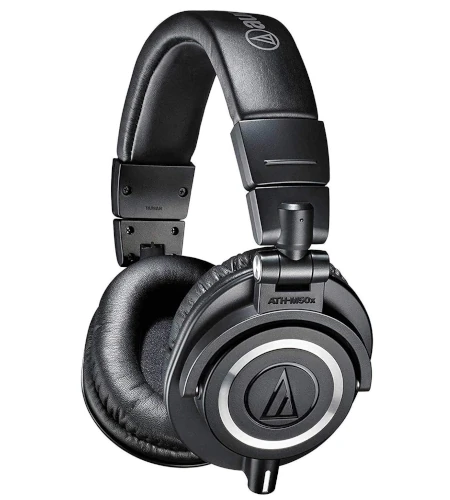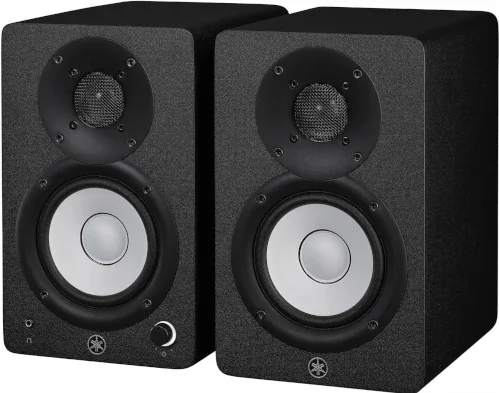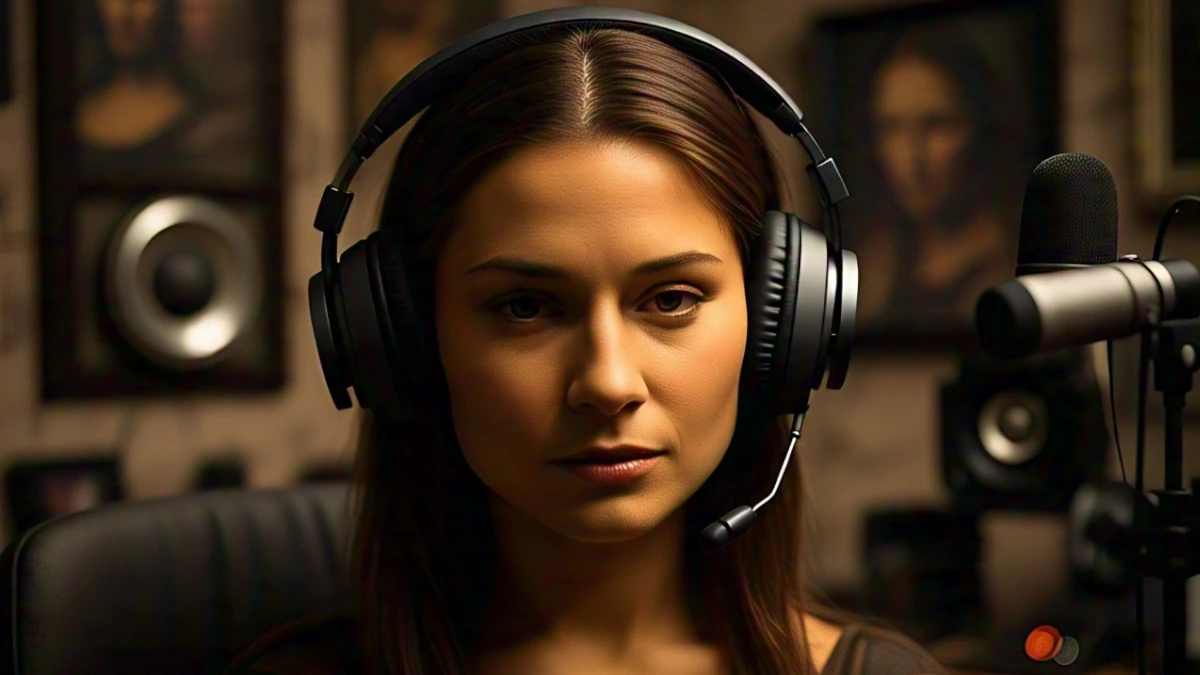HSS Podcast - Headphones vs. Monitors: The Ultimate Showdown for Your Home Studio Setup
HSS Staff
Welcome to the sound battleground where every music producer, sound engineer, and home studio enthusiast ultimately finds themselves! Have you ever wondered whether to jam out with headphones or to let your tunes bloom through studio monitors? Well, you’re not alone! This thrilling debate is like choosing between chocolate and vanilla – it all boils down to your personal taste, workflow, and what you want to achieve in your sonic sanctuary.
Picture this: You’ve just got your hands on the latest DAW, and you can’t wait to create that next masterpiece. You reach for your trusty pair of headphones, but just as you get settled, that little voice in your head says, “But what if my monitors could deliver a wider soundstage?” The tension is real, and the stakes are high! So, what’s the scoop? Which setup is best for you? With growth in the home studio revolution, knowing the differences between headphones and monitors is more vital than ever — and trust me, understanding these two will impact your music production journey dramatically!
In this blog post, we’ll dive deep into the key features, advantages, and disadvantages of both headphones and studio monitors. We’ll share real-life experiences, actionable tips, and even some case studies to help you make an informed decision. Whether you’re tracking instruments, mixing vocals, or simply vibing out to your favorite beats, we’re here to guide you through the headphones vs. monitors conundrum, ensuring you walk away with insights that will elevate your home studio game to new heights!
So hang tight, as we’re about to take a thrilling ride through the sound waves of headphones and monitors. Ready to find out which pair will wear the crown in your studio? Let’s jump right in!
1. Sound Accuracy and Stereo Imaging
When it comes to creating music in a home studio, understanding sound accuracy and stereo imaging is crucial. This is where the debate between headphones and monitors heats up. Let’s dive into what these terms mean and how they affect your mixing and production.
Understanding Sound Accuracy
Sound accuracy refers to how true the audio is to the original source. Think of it like this: when you hear a piano being played, you want the recording to sound just like that piano sounds in real life. Monitors, specifically studio monitors, are designed to give you a flat response across the frequency range, meaning they don’t artificially boost or cut any frequencies. This allows you to hear your mix as it is, rather than how it might sound colored by your headphones. For instance, a pair of Yamaha HS8 monitors is known for its flat response, making it easier for producers to catch errors in their mix.
On the other hand, headphones can often enhance certain frequencies, especially bass. While this might sound great for casual listening, it can lead to misleading results in your mixes. Imagine spending hours perfecting a bass line on headphones, only to find out it sounds weak on speakers!
The Importance of Stereo Imaging
Stereo imaging is all about how sound is placed within the left and right channels. It’s essential for creating a three-dimensional listening experience. Monitors typically provide a wider soundstage, allowing you to perceive the placement of instruments better. For example, when using monitors, you can easily distinguish between a guitar panned left and a keyboard panned right. This spatial awareness is crucial for creating a balanced mix.
Headphones, while convenient, can sometimes create an artificial sense of space, leading to a “tunnel” effect. This can result in mixes that sound great on headphones but fail to translate well to other listening environments. To combat this, try using an imaging plugin like iZotope Ozone to visualize your stereo field while mixing on headphones.
In summary, when considering sound accuracy and stereo imaging in your home studio, monitors often take the lead. They provide a clearer and more accurate representation of your mix, essential for producing professional-sounding music. However, using both can be beneficial; just be sure to cross-check your mixes on different systems to get the best of both worlds!
2. Room Acoustics Impact
When discussing the advantages of headphones vs. monitors in a home studio, it’s essential to dive into the often-overlooked factor of room acoustics. The environment where you create and mix music plays a crucial role in how sound is perceived. If your room is not acoustically treated, it can lead to misleading audio references, which can misguide your mixing decisions.
Understanding Room Acoustics
Room acoustics refer to how sound waves interact with the walls, ceiling, and floor of your studio. Hard surfaces can reflect sound, creating echoes and standing waves that muddy your mixes. On the other hand, soft furnishings can absorb sound, which helps to clear up the audio. For instance, if you’re mixing a track in a small, untreated room with a lot of bare walls, you might think your bass is booming when, in reality, it could be non-existent in a more neutral listening environment.
Headphones: A Safe Haven?
Using headphones can sometimes shield you from the negative impacts of poor room acoustics. They deliver sound directly to your ears, minimizing the influence of your environment. This direct sound can be invaluable for critical listening tasks, such as identifying frequencies that need adjustment. However, keep in mind that headphones can create a false sense of stereo imaging, which may lead you to make adjustments that don’t translate well to speakers.
Monitors: The Room’s Role
Conversely, studio monitors rely heavily on room acoustics. For example, placing your monitors too close to the walls can lead to bass buildup, skewing your perception of low frequencies. To combat this, consider positioning your monitors away from the walls and using acoustic panels to manage reflections. You might even explore bass traps in the corners of your room to ensure a more accurate low-end response, making your mixes more reliable across different playback systems.
Practical Tips for Improvement
- Test Your Room: Use an app to measure your room’s acoustic response. This will help identify problematic frequencies.
- Use Absorption Panels: Invest in some affordable acoustic panels to reduce reflections and improve clarity.
- Monitor Placement: Aim to set your monitors in an equilateral triangle with your listening position to ensure optimal sound distribution.
In summary, while headphones can provide a controlled listening environment, monitors require a bit more attention to room acoustics for an accurate representation of your mix. Understanding and improving your room’s acoustics can significantly enhance your overall sound quality, making your choice between headphones and monitors all the more impactful.
3. Comfort and Extended Use Considerations
Understanding Comfort in the Studio
When diving into the world of audio production, whether you’re a budding music producer or a seasoned pro, comfort plays a pivotal role in your choice between headphones and monitors. Let’s be real—long hours in the studio can take a toll on your body, especially your ears and neck.

Headphones can often feel snug, pressing against your ears for extended periods. This pressure can lead to discomfort or fatigue. For example, if you choose over-ear headphones with plush padding, they might be more comfortable than on-ear options, which can cause more strain over time. A great recommendation here would be the Audio-Technica ATH-M50x—they’re well-padded and great for long sessions.
On the flip side, studio monitors allow for a more natural listening experience. You can adjust your position and take breaks without the restriction of having headphones on your head. This can prevent neck strain and keep you fresher for longer. Opting for monitors that come with adjustable stands can also enhance your comfort by allowing you to position them at ear level, which minimizes stress on your neck.
Extended Use: The Impact of Volume Levels
Another point to consider is how both options handle sound pressure levels during extended use. Headphones, especially if cranked up high, can lead to ear fatigue or even permanent hearing damage if used excessively at loud volumes. A practical tip would be to take breaks—every hour, give your ears a rest and lower the volume.

In contrast, studio monitors are designed to operate at lower volumes without sacrificing clarity. This means you can listen longer without the fatigue associated with headphones. A good example is the Yamaha HS series, which allows for clear monitoring at a range of volumes, making them ideal for lengthy sessions.
In summary, when considering comfort and extended use, think about how each option will affect your workflow. Prioritize products that cater to your long-term comfort needs, whether you lean towards headphones or monitors.
4. Mixing and Mastering Perspectives
When it comes to mixing and mastering in a home studio, the debate between using headphones and monitors is a hot topic. Each option brings its own unique benefits and drawbacks, and understanding these can significantly enhance your production quality.
Headphones: Precision and Isolation
Headphones offer a level of precision that can be quite beneficial during the mixing phase. For instance, closed-back headphones can help isolate the sound, allowing you to hear nuances in your mix that might otherwise be masked by room acoustics. This is especially useful in untreated rooms where reflections can distort the sound.
Consider the example of a producer who mixed an entire album using high-quality studio headphones. By carefully listening to each track in isolation, they were able to identify frequency clashes and make adjustments that improved clarity. The result? A polished album that stood up well when played on various sound systems.
Monitors: The Bigger Picture
On the flip side, studio monitors provide a fuller soundstage that allows you to hear how your mix translates in a real-world environment. When you mix using monitors, you’re more likely to catch issues like imbalanced levels or frequency buildup. This is crucial as music often gets played on different systems, from car stereos to tiny Bluetooth speakers.
Imagine a scenario where a mixing engineer spent hours tweaking a track on headphones, only to discover that the bass was too overpowering when played on monitors. This common pitfall can be avoided by using monitors to get a better sense of the overall mix.
Practical Tips
To leverage the strengths of both headphones and monitors, consider these practical tips:
- Start with headphones: Use your headphones for detailed editing and spotting issues.
- Switch to monitors: After making adjustments, check your mix on monitors to ensure it translates well.
- Use a reference track: Play a professionally mixed track on both headphones and monitors to compare and calibrate your ears.
By blending the strengths of both listening methods, you can elevate your mixing and mastering game, ensuring your tracks sound great across various playback systems!
5. Budget and Practical Considerations
When it comes to setting up a home studio, one of the most significant factors to consider is your budget. Both headphones and studio monitors can vary widely in price, and understanding how to allocate your resources effectively can make a huge difference in the quality of your sound and your overall production experience.
Initial Investment
Generally speaking, good quality studio monitors can range from $200 to over $1,000 per pair, depending on the brand and specifications. For example, popular models like the Yamaha HS5 or KRK Rokit 5 are great entry-level options, typically priced around $300-$500 per pair. On the other hand, a decent pair of studio headphones can start as low as $50 and reach up to $500 or more for high-end models like the Sennheiser HD 600 or Audio-Technica ATH-M50x. Depending on your budget, you can consider investing in monitors first for a more spacious sound stage, or go with headphones if you’re looking to save space and money.
Space Considerations
Another practical aspect is space. Studio monitors require a dedicated setup area, as they need to be positioned properly to achieve optimal sound. This means that your studio should have adequate room and treatment to avoid acoustical issues. If you’re working in a smaller space or a shared environment, good headphones often provide a more practical solution. They allow you to work on your tracks without disturbing others, and they take up significantly less physical space.
Flexibility and Portability
Headphones also offer greater flexibility for those who need to work on the go. If you find yourself traveling often or working from different locations, a good pair of headphones can be a lifesaver. Imagine being able to finish a mix on the bus or in a café! Meanwhile, monitors usually stay in one place, which can limit your creativity when you’re away from your main setup.
Actionable Tips
- Set a Budget: Determine how much you’re willing to spend before you start shopping. This will help narrow down your choices.
- Try Before You Buy: If possible, visit a local music store to test out various models of monitors and headphones to find what suits your style.
- Consider Second-Hand Options: Don’t overlook the possibility of purchasing used gear. Often, you can find high-quality equipment at a fraction of the price.
By weighing these budget and practical considerations, you can make an informed decision that aligns with your needs and enhances your home studio experience.
Conclusion: Choosing the Right Audio Tool for Your Home Studio
In the dynamic world of music production, the choice between headphones and monitors can significantly impact your creative process and final output. Each tool offers unique advantages and limitations that cater to different aspects of audio mixing and production.
Understanding the Key Differences
Headphones provide an intimate listening experience, allowing you to hear intricate details in your mix without disturbing your environment or neighbors. They excel in isolating sound, which can lead to precise audio adjustments.
On the other hand, studio monitors deliver a more accurate representation of your audio. They allow you to experience how your music translates in various listening environments, providing a full-spectrum sound that headphones sometimes miss. This clarity is crucial when you’re mixing and mastering tracks for broader audiences.
Real-Life Applications
Many successful producers blend both tools in their workflow. For instance, Grammy-winning mixer Michael Brauer often utilizes monitors for overall mixing sessions but switches to high-quality headphones for final tweaks. This hybrid approach allows him to reap the benefits of both worlds, ensuring his mixes sound great on all systems.
Actionable Tips
Ultimately, the decision depends on your specific needs, environment, and budget. Here are a few actionable tips to guide your choice:
- Assess Your Environment: If you have a quiet space, monitors can deliver impressive sound. However, if you live in an apartment or a shared space, high-quality headphones might be your best bet.
- Budget Wisely: Quality matters. Consider investing in one high-quality tool rather than buying both lower-tier headphones and monitors.
- Mix and Match: Don’t hesitate to use both! Many producers find that switching between monitors and headphones can help them identify issues that might be missed with just one option.
By understanding the distinct roles that headphones and monitors play, you can make an informed choice that aligns with your personal workflow and creative aspirations. So, whether you lean towards the isolation of headphones or the spatial awareness offered by monitors, the key is to discover what works best for you.

